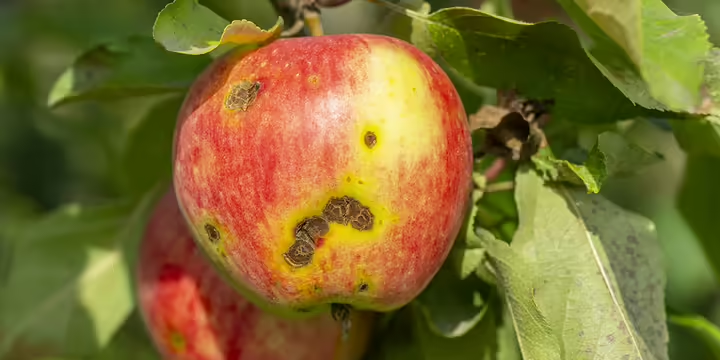Growing Apple Trees
Planting
Apples are the most popular backyard tree fruit for northern Illinois and other parts of the state. Apples grafted on dwarfing rootstocks occupy less space as compared to trees grafted on semi-dwarf and seedling rootstocks.
- Plant apples on a site with full sun and well-drained soil.
- Dig a hole that will accommodate all the roots.
- Plant at a proper depth based on the type of rootstock (graft union 3-4 inches above soil line for trees grafted on dwarfing rootstocks and below soil line for standard trees).
- Prune the plant by heading it back to 30 inches tall immediately after planting.
- Plant at least two varieties to assure cross-pollination. 'Winesap' and 'Turley' have sterile pollen, so don't include it as a pollinating variety in the plan.
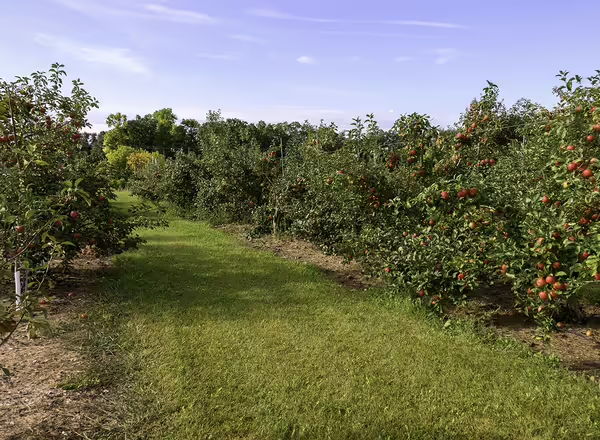
The central-leader system is suggested for apple trees growing on all types of rootstocks. The system is modified somewhat for various rootstocks, spur-types, and different varieties.
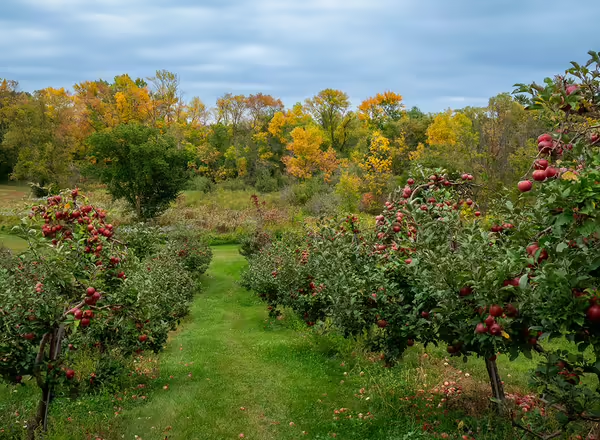
The suggested structure for dwarf apple trees is a 4 to 6 feet tall trunk with 6 to 10 scaffold branches spaced around the trunk (except towards the southwest). The scaffolds should be spaced from 2 to 6 inches apart vertically (center to center) along the trunk, in clusters spaced about 18 inches apart, or in a combination of cluster and spaced branches. The lowest scaffold should be about 18 to 22 inches above the ground. A short trunk with close branch spacing results in a smaller, more compact tree.
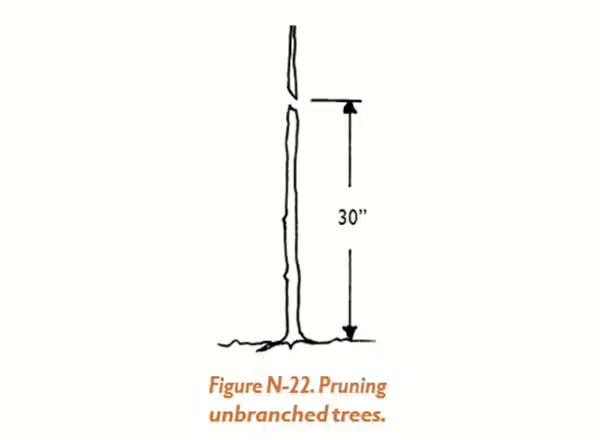
Dwarf trees may not have strong anchorage and may need support to prevent them from blowing over. They may start bearing when 2 or 3 years old. Early bearing may distort the shape of the tree because of the weight of the fruits. It is especially important in young trees to prevent the main leader from being bent over.
Pruning at planting time. If unbranched trees are planted, cut off the shoot about 30 inches above the ground (Figure N-22).
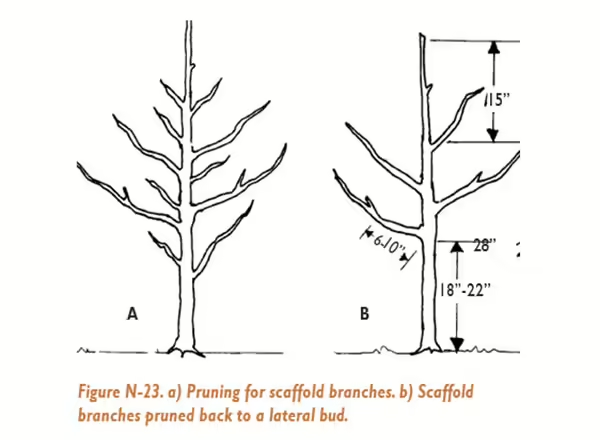
If branched trees are planted, it is sometimes possible to select and save branches for the first tier of scaffold branches. Branches to be selected should have wide crotch angles, should arise between 18 and 28 inches from the ground, should be spaced about evenly around the trunk, and should be about equal in size. Shorten the selected branches to 6 to 10 inches long, and cut the leader about 15 inches above the crotch of the highest branch. Remove all other branches (Figure N-23). If 3 or 4 desirable branches cannot be selected, it is better to remove all branches and cut the leader 30 inches above the ground, as suggested for unbranched trees.
Pruning after 1 year.
After one growing season, from two to four scaffolds usually can be selected. Remove the other branches and cut back the main leader about 15 to 18 inches above the crotch of the highest scaffold. Cutting back the main leader stiffens the trunk and forces new branches to develop above the highest scaffold. Shorten any excessively long scaffolds. Branch spreaders help to prevent branches from growing straight upward.
Pruning after 2, 3, 4, and 5 years.
Continue the selection of scaffold branches. One, two, or three may be selected each year depending on the growth of the tree and the location and crotch angle of the branches available. Prune out other branches and shorten any excessively vigorous scaffolds. Cut off the main leader each year about 15 to 18 inches above the crotch of the highest scaffold. Use branch spreaders where needed.
Most of the permanent framework of the tree should be selected by the end of the fourth year. Trees should be bearing fruits.
The suggested structure for semi dwarf and spur type trees is a 5 to 8 feet tall trunk with 6 to 12 scaffold branches spaced around the trunk (except growing toward the southwest). Vertically the scaffolds should be spaced from 4 to 8 inches apart (center to center) along the trunk, in clusters spaced about 24 inches apart vertically, or in a combination of clusters and spaced branches. The lowest scaffold should arise from the trunk about 18 to 22 inches above the ground.
The taller trunk with greater spacing between scaffolds (as compared with dwarf trees) provides more space for these somewhat more vigorous trees and enables them to develop a strong framework. Varieties on M 7 may be poorly anchored until they are about 10 years old. They sometimes need support from their 4th through their 10th year in the orchard.
Standard apple trees will be larger than dwarfs and semi-dwarfs. The trunk should be 6 to 10 feet tall and the scaffolds spaced 8 to 15 inches apart, in clusters spaced 30 to 36 inches apart, or in a combination of clusters and spaced branches. The number of scaffolds selected may vary from 10 to 15. The height of the trunk will vary with the number of scaffolds: the more scaffolds selected, the taller the trunk required. Some growers prefer fewer scaffolds, allowing them to become large; others prefer more scaffolds of smaller size.
Training at planting time and through the first 5 years. The system of pruning standard apple trees at planting time and after 2, 3, 4, and 5 years is similar to that described for dwarf trees except for the differences in number of scaffolds and the vertical spacing along the trunk. Standard trees may grow more vigorously and usually are slower coming into bearing than those on dwarfing rootstocks. They may require more severe pruning and may need special treatments to bring them into bearing.
Pruning after 6 to 10 years. During this period make any selections needed to complete the framework. The main leader may be removed back to the top scaffold (suggested for standard trees) or it may be allowed to bear fruits. On dwarf and semi-dwarf trees, allowing the top of the main leader to bear fruit usually bends it over and the top of the main leader then becomes the highest scaffold.
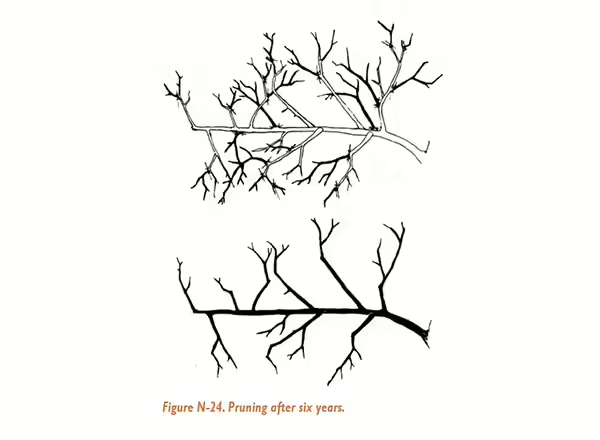
Also, some thinning-out cuts will be necessary to prevent the trees from becoming too dense (Figure N 24.). Dwarf trees can be left denser than semi-dwarf trees and both can be left denser than standard trees because there is less shading of the lower limbs.
Dwarf, semi-dwarf, and spur-type trees should be bearing regularly and producing moderately heavy crops during this time. Standard trees should start bearing after their sixth year and by the 10th year should be bearing regularly and moderately heavy crops. Pruning should be light to moderate to encourage bearing.
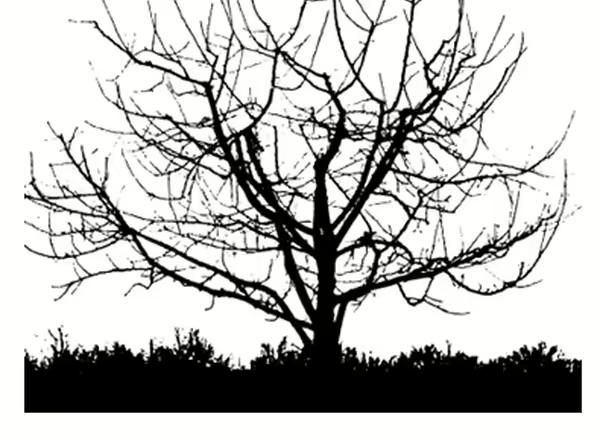
Pruning after 10 years. Pruning now should be heavier. Trees should be in their prime bearing years. Bearing surfaces must be renewed by cutting out older wood and encouraging new growth. Trees will be growing tall and broad unless branches are shortened. Annual thinning-out pruning is needed to keep the trees open and prevent them from becoming too dense. Summer pruning may be helpful in maintaining the desired tree size.
As trees grow older they lose some of their vigor. To overcome this loss of vigor, the amount of annual pruning should be increased (Figure N-25).
Revitalizing Old Trees
Trees not properly trained when young, and trained trees that have not been pruned for several years usually develop the following conditions: they have too many branches; the trees are tall; lateral branches are long; and the tree is too dense, so that sunlight does not penetrate the interior of the tree.
The first step in pruning is to select six to ten of the better branches for scaffolds. These will usually be the larger branches with wide-angle crotches. The other branches arising from the trunk should be removed over a 3-year period, cutting out about one third each year. Spreading this branch removal over a 3-year period reduces the shock to the tree. Excessive pruning at one time may upset normal bearing for several years.
Long or tall scaffolds should be shortened. Some thinning out of these selected scaffolds probably will be needed.
Do not fertilize trees during this corrective pruning period. The corrective pruning will provide enough stimulation of growth.
